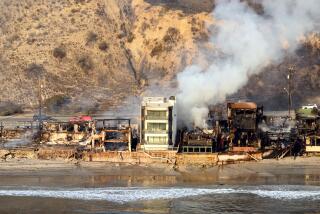2 Key Factors Kept Latest Fire in Check
- Share via
The fire that ravaged part of the 34th floor of the Union Bank building Monday night could have been much worse--possibly equaling the destruction of the May 4 fire at the nearby First Interstate Bank building--if not for important differences in the way the blazes broke out and in the structures of the two buildings, officials said Tuesday.
Firefighters were able to contain the Union Bank fire well within an hour, partly because work crews in the 40-story building spotted the fire as soon as it broke out and because the Fire Department was called to the scene almost immediately, Fire Inspector Ed Reed said.
Solid Walls Helped
In addition, the older-style structure of the Union Bank building--with solid walls creating many separate rooms on the same floor--played a vital role in containing the blaze while firefighters struggled to get equipment off their trucks and up to the 34th floor through the stairwells, Reed said.
By contrast, the First Interstate fire occurred while no one was present on a floor characterized by large open areas of desks and cubicles. That fire was the worst high-rise blaze ever in Los Angeles, killing one maintenance worker and engulfing four floors of the city’s tallest office building. Repair crew are still in the early stages of repairing the 62-story structure.
“If not for the compartmentalized type of construction (at Union Bank), you would have had another First Interstate type of fire here,” Fire Department spokesman Gary Svider said Tuesday.
Reed, who compared the two blazes after touring the Union Bank building, said Fire Department response times to the fires were almost identical: In each case, the first units arrived on the scene three minutes after receiving the first alarm.
Firefighters also required about the same time to reach the burning floors--perhaps 25 to 30 minutes, Reed said. At the First Interstate building, they had to carry their equipment up 12 stories, a task that was slowed by heavy smoke in the stairwells. Because there was little or no smoke in the Union Bank stairwells, fire crews were not forced to don breathing masks and traveled the greater distance at a faster pace.
Investigators still do not know how much of the damage at First Interstate was attributable to delays in finding out about the fire, Reed said. He speculated that the blaze there may have smoldered and burned for half an hour or more before it triggered fire sensors in the building. At that point, he said, security guards apparently turned off the alarms, thinking there was no fire, which resulted in a seven-minute delay before firefighters were summoned.
Security officials denied that there was any delay, but fire officials say it is clear that the First Interstate fire spread much farther than the Union Bank fire before help arrived.
One significant factor undoubtedly was the differing styles of building construction, Reed said. Another was probably the types of furnishings that each building contained.
The 12th floor of the First Interstate building was crammed with computers, containing large amounts of plastic.
“Plastics are petrochemicals (and) petrochemicals are made out of the same materials as gasoline,” Reed said. “When they burn, they generate a tremendous amount of fire, heat and smoke.”
The 34th floor of the Union Bank tower was filled with combustible, but less volatile, law books, desks and chairs. The floor was used by the law firm of Hill, Farrer & Burrill.
“The volume of . . . combustibles in the First Interstate building was much, much higher,” Reed said.
As a result, firefighters who arrived at First Interstate found that the blaze already had consumed all of the 12th floor and much of the two floors above, he said.
ANOTHER HIGH-RISE FIRE, BUT WITH A DIFFERENT ENDING Monday’s blaze at Union Bank Square, right, brought to mind the terror of May 4, when fire ripped through four floors of the First Interstate Bank, left, killing a maintenance worker and injuring 40 others. Fire officials said the Union Bank fire would have been a repeat of First Interstate except for two important differences: the blaze was detected quickly because workers were nearby, and the building’s interior walls helped impede the flames.
First Interstate Bank Alarm time 10:37 p.m. First units on scene 10:40 p.m. Number of units 58 fire companies; 6 rescue units; about 300 firefighters Knockdown time 3 hrs, 43 mins. Tentative cause Accidental Dollar loss Not determined Casualties 40 injured; 1 killed Building height 62 stories Floors involved 12th through 15th (16th partially damaged) Type of construction Open, few interior walls (interior walls impeded spread of flames) Sprinkler installation Nearly complete; but not yet operable. Standpipe shut off.
Union Bank Alarm time 8:23 p.m. First units on scene 8:26 p.m. Number of units 43 fire companies; 1 rescue unit; about 160 firefighters Knockdown time 43 mins. Tentative cause Accidental Dollar loss $500,000 Casualties 1 injured Building height 40 stories Floors involved 34th and 35th Type of construction Compartmentalized Sprinkler installation In early stages; system not operable. Standpipe operable.
Source: Los Angeles Fire Department
Research by ERIC MALNIC, DAVID FERRELL / Los Angeles Times
More to Read
Sign up for Essential California
The most important California stories and recommendations in your inbox every morning.
You may occasionally receive promotional content from the Los Angeles Times.













